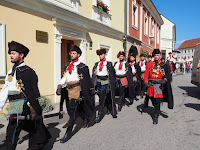 |
| Prague. |
***********************************
At the spacious Graben pedestrian boulevard in Vienna near St. Stephens Cathedral, we stopped at Espresso Segafredo to savour the Saccher-Torte and Apple Strudel.



*************************************************




Pivnice Stupartska - a traditional Czech pub serving Gambrinus beer. Gambinus is one of the most popular beers in Czeh Republic. Brewery was set up in 1869.
***********************************************


Zagreb.
*************************************
At the huge square in front of the Great Market Hall in Budapest, a cup of coffee or a glass of beer in one of the sidewalk cafes is perfect to watch people. And if you are lucky like in our case, we were entertained by the non-stop performance of a street musician.


**************************************
 |
| At a cafe overlooking Dolac Market, Zagreb. |







































